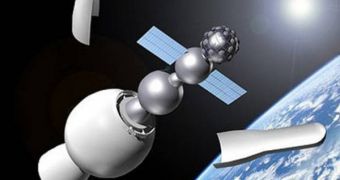With more than 17 teams already signed up in the competition, the Google Lunar X Prize promises to be one of the most interesting show-offs in history. All participants need to construct a delivery system that will get their rover to the Moon, where the robot has to drive for about 500 meters, take high-resolution pictures of its surroundings, and then send them back home. Breaking a bit from the designs of other competitors, the Romanian ARCA (Aeronautics and Cosmonautics Romanian Association) team opted for a balloon-delivered rocket, which would ignite its three stages in the upper atmosphere.
This type of design means that the need for a launch pad is overcome from the get-go. Additionally, the balloon, which roughly resembles a hot-air one, but works on a totally different operating principle, can be launched from around the Equator, in the middle of the Atlantic Ocean. The delivery system, with its ball-like rover inside, would remain attached to the balloon until it reaches a height of about 11 miles (18 kilometers) into the upper atmosphere. At that point, the rocket would ignite its fuel, and would continue to orbit on its own.
Once the delivery system reaches low Earth orbit, it will deploy the European Lunar Explorer (ELE) spacecraft, which will then travel to the Moon on its own. Once there, it will have to deploy the Lunar Lander explorer, which is an odd-shaped, ball-like robot. The Lander is itself equipped with rocket boosters, meant to slow its descent and ensure a soft landing on the surface of the Earth's natural satellite. According to the team, the STABILO propulsion system has already been completed in March, and is now about to get its first test.
“We have the experience now, we have the know-how, we have a list of companies that can help us, we have connections. We already have some technology from the previous competition,” Space quotes ARCA Project Manager Bogdan Sburlea as saying. “Our design for the lander is extremely simple, it's a sphere. It's too complicated, too expensive to build a robot,” the expert added. He also said that the team did not rely on the Romanian government for assistance, but rather enlisted the help of some of the country's most prominent businessmen. This is the very idea of the Google X Prize, which aims to demonstrate that privately owned vessels can make it to the Moon.

 14 DAY TRIAL //
14 DAY TRIAL //